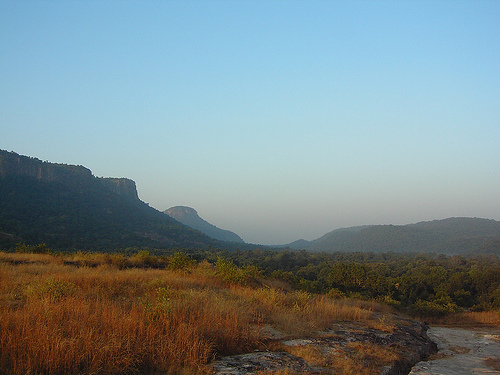

Location: Shahdol District Map
Area: 437 km²
MP Tourism, White Tiger Lodge, Tala (07653) 26 5308
Open: Oct- Jun
Bandhavgarh National Park is a nature reserved situated in Shahdol District in India. Bandhavgarh National Park covers an area of 437 km² that were established here in 1968. The best time to come to the nature reserve is between October and June during driest and coldest months of the year. Between July and September the nature reserve is closed due to dangerous flush rains. Additionally the national park has the highest density of tigers including a sizeable colony of white tigers. These beautiful and graceful animals are best viewed from a windows of vehicle rather than encounter in the wild jungle. This explains why tourists come here on safaris that are allowed inside Bandhavgarh twice a day.
Fort
A 2 thousand year old fort is built on the hill of Bandhavgarh .
Forest
The forest area of Bandhavgarh is full of different types of flora
and fauna. The forest has all kinds of wildlife and trees including
Nilgai and Chinkara .
Wildlife
There are 22 species of animals and 250 species of birds in this
national park. These wildlife can be seen riding on elephant or
sitting in a vehicle.
The park entrance is in the small town of Tala. Most tourists will travel to Tala via Umaria, about 30km away. Buses leave from the bus station there from 7 a.m. in the morning. You can reach the bus station by rickshaw or by walking straight ahead from the train station, over the roundabout and then following the street signs for about 3 kilometers. The last bus to Umaria leaves from Tala at approximately 5pm.
Tala itself is so small that you can easily reach everything on foot. There are several buses to Umaria every day. The last one at about 5 p.m.
The number of accommodations is relatively limited. During peak
travel times, it may make sense to reserve a room in advance.
Kum
Kum House, Rewa Road, Tala, Madhya Pradesh (inside the park). A simple
room with a double bed and an Indian style toilet costs ₹ 250. The price
is a bit negotiable and may be a little cheaper in the low season. There
are also even better rooms that have a cooler in addition to a normal
ceiling fan. The attached restaurant serves simple Indian food (rice,
dal, chapatti and vegetables) for ₹50.
Bandhavgarh was the hunting ground of the Maharajas of Rewa. The majestic tiger was the preferred prey. In the early 1960s, when the area's forests suffered from heavy poaching, an area of around 105 km² was placed under protection by Maharaja Martand Singh. The protected area was further enlarged from this core zone and declared a national park, which in 1982 covered around 448 km². Today the park is one of the best managed protected areas, with the involvement of the local population.
The hilly landscape is dominated by a plateau on which the Maharajas' fort once stood. In the surrounding area there are grassy areas rich in wildlife that emerged from swamps that were once created to protect the fort. Some of these swamps still exist. Sal forests also dominate.
The park's best-known animal species is the Bengal tiger, of which
almost 50 animals lived in the park in 1997. The big cats are not very
shy and are particularly easy to observe here.
A white tiger was
captured in this area in 1957, and its offspring can be seen in zoos and
circuses around the world. Other predator species in the area include
leopard, striped hyena, sloth bear, wild dog, cane cat, golden jackal,
spotted musang and Indian mongoose. The large herbivores are represented
by sambar deer, axis deer, Indian muntjacs, spotted chiles, four-horned
antelopes, Indian gazelles, Nilgau antelopes, and wild boars. Among the
mammals, the Indian pangolin and the langur should also be mentioned.
There are also around 200 species of birds in the park.
In 1995
there was still a remaining population of gaur in the park, but the huge
wild cattle disappeared in the following years for unknown reasons. The
gaur has now been reintroduced to the park. In 2011, 19 animals and 31
animals in 2012 were brought from Kanha National Park to Bandhavgarh.